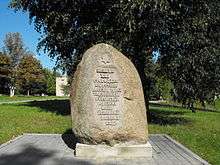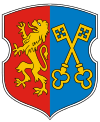Lida
| Lida Ліда Лида | |||
|---|---|---|---|
|
| |||
| |||
 Lida Location of Lida | |||
| Coordinates: 53°53′N 25°18′E / 53.883°N 25.300°E | |||
| Country Subdivision |
Belarus Hrodna Voblast | ||
| Founded | 1323 | ||
| Government | |||
| • Mayor | Andrei P. Hudyk | ||
| Area | |||
| • Total | 50 km2 (20 sq mi) | ||
| Elevation | 158 m (518 ft) | ||
| Population (2015)[1] | |||
| • Total | 99 976 | ||
| Time zone | EET (UTC+2) | ||
| • Summer (DST) | EEST (UTC+3) | ||
| Postal code | 231300 | ||
| Area code(s) | +375 154 | ||
| License plate | 4 | ||
| Website | Official website | ||
Lida (Belarusian: Лі́да; Russian: Ли́да; Polish: Lida; Yiddish: לידא) is a city in western Belarus in Hrodna Voblast, situated 160 kilometres (99 miles) west of Minsk.
Etymology
The name Lida is derived from the name of the river Lidzeya. Its origin is associated with the Lithuanian appellative Lyda - Lydimas, meaning to fuse, to cast (denoting forest clearing).[2] Names in other languages are spelled as Polish: Lida and Yiddish: לידע.
History
Medieval origin
There are passing mentions of Lida in chronicles from 1180. Until the early 14th century the settlement at Lida was a wooden fortress in the Lithuania proper. In 1323, the Grand Duke of Lithuania Gediminas built a brick fortress there. 1380 is generally considered the founding year of the city of Lida. The fortress withstood Crusader attacks from Prussia in 1392 and 1394 but it was burned to the ground in 1710. Following the death of Gediminas, when Lithuania was divided into principalities, Lida became the capital of one of them, the seat of Algirdas.
Grand Duchy of Lithuania
Lida was in the Grand Duchy of Lithuania. In the second half of the 14th century, after the Christianization of Lithuania the Catholic parish was established in former pagan lands and a Church was built by Jogaila (ruins are still preserved). Subsequently in the 15th-century town the became a centre of production by craftsmen and trade. Lida was connected with Vilnius, Navahrudak and Minsk. At that time the town had a market square and four streets: Wielenska, Zamkowa, Kamieńska and Krivaya. In 1588, Lida became the seat of Lida District in Vilnius Voivodeship. Magdeburg Rights were granted to the town in 1590 and confirmed in 1776 by the Polish Sejm. By these rights Lida held two annual fairs of little import to the local economy. The population was between 2,000 to 5,000 people. It was part of the Russian Empire after the third partition of the Polish–Lithuanian Commonwealth in 1795.
Jewish Community of Lida
Jews first settled in Lida in the middle of the 16th century, and permission to construct a synagogue was granted by King Stefan Batory in 1579. The temple was decimated and rebuilt with the permission of King Wladyslaw Vasa in 1630. By 1817, the Jewish Community of Lida numbered 567, nearly three-quarters of the total population of the city at the time. Lida had a particularly sightly brick synagogue. Old photographs can be found.[3][4]
During the First World War, the Germans captured Lida, and both Jews and non-Jews were forced into labor. Soon after the German Occupation ceased in the winter of 1918, the Bolsheviks entered the city and created a strong sense of the Revolution. In 1919, Polish soldiers entered Lida and a pogrom occurred, in which 39 Jews were slaughtered. After the Riga Treaty it was passed to Poland and became powiat (county) centre in Nowogródek Voivodeship. Between the wars was a short period of economic growth for the Jewish community. All aspects of the community flourished, and at the time there were 12 fully functioning synagogues. In 1931, the Jewish population grew to 6,335, and at the dawn of the Holocaust refugees added to make it nearly 8,500. In the fall of 1939, the Red Army moved in and annexed Lida to the Baranavichy Voblast of Byelorussian SSR, part of the Soviet Union. Once again, the Jews were oppressed and all cultural aspects of the community were diminished and the Soviets imprisoned surrounding Jews in Lida. In June 1941, the Germans severely damaged the city, and by December of that year, a ghetto was created on the suburbs of Lida, in which several families ended up crowding into a single home. On May 7, 1942 the ghetto was sealed and on the 8th nearly 6,000 were taken to a military firing range, where they were shot and piled in ready-made grave pits. About 1,500 educated Jews remained in the ghetto, and the population was added to by incoming refugees. A few groups secretly escaped the city and hid in the forests until the city was liberated in 1944, but the rest of the community was murdered on September 18, 1943. It was passed to newly created Grodno Voblast in 1944.
Polish-Lithuanian Commonwealth and Imperial Russia

The 17th century was a difficult time in Lida. Caught by invading to Polish-Lithuanian Commonwealth forces of Russia and Sweden. A depression resulted, and people moved out of Lida. By 1786, 514 inhabitants were left in Lida. in 1795, Lida was annexed by the Russian Empire as a powiat centre of the Slonim Governorate (1795). Afterwards, Lida was a part of the Lithuania Governorate in 1797 and of Grodno Governorate since 1801.
The town was greatly destroyed during the French occupation in 1812. In 1817 the population was 1366 people. Since 1842 Lida was the "district" centre in Vilna Governorate. In 1863 and 1873, two beer factories were built in Lida. In 1884, the railway Vilnius-Lunenets was finished. In 1907, the railway Molodechno-Mosty opened. The 1897 population was 8626 people.
A two-year school opened. Then, a parish school with the department for girls opened as did a Jewish school. In 1899 a hospital opened which consisted of 25 beds. In 1901 cast-iron plant began to operate. In 1903 sawmill started its operation. At the end of 19th century and at the beginning of 20th century two brick plants were built. In 1904, there were 1000 houses of which 275 were brick, fourteen small enterprises, four hospitals with beds for 115 people, and six elementary schools for 700 pupils. In 1904, near Minsk the Russian Social Democratic Party was formed. During the revolutions of 1905-07, the uprisings of the workers took place, complete with political slogans. In 1914, there were almost 40 factories.
Recent history
During World War I Lida was occupied by the German troops. In 1919 the Red Army established Soviet power.
Polish troops under General Józef Adam Lasocki reached the outskirts of Lida in early March 1919. On April 15 they resumed their advance and on April 17 they captured Lida, as a screening operation to the taking of Vilnius.
On July 17, 1920 the Red Army returned but was forced to retreat in August following the Soviet defeat at Warsaw.
On September 30, 1920 Poland and Soviet troops fought in and near Lida during the battle of Niemen, as the Soviet 21st Rifle Division tried to assault Polish positions but was repulsed by the 1st Lithuanian-Belarusian Division; Poles took about 10,000 prisoners from the Soviet 3rd Army.[5]
After the 1920 Moscow Treaty it was ceded by the Soviets to Lithuania, this treaty however was not recognized by Poland. In accordance with Riga Peace Treaty of 1921, the town was awarded to Poland as the powiat centre in Nowogródek Voivodeship.
In 1927, there were twenty-four factories in Lida. 1928 were years of rapid growth in the production. A new rubber good's factory started up, employing almost 800 people. Also, Lida was an important garrison of the Polish Army, with one infantry division and the 5th Corps of the Polish Air Force stationed there.
In 1939, following the Soviet invasion of Poland, Lida became part of the Byelorussian Soviet Socialist Republic. Beginning January 1940 Lida was the centre of Lida Raion, Baranavichy Voblast.
From June 1941 to July 1944, it was occupied by the German troops who killed almost 25,149 people. On September 18, 1943, the Jewish Community of Lida was rounded up and taken to Majdanek, where they were murdered. A small number of about 200 Lida Jews survived the Holocaust. Beginning of September 1944, Lida was in Grodno Region.
During the Cold War and up until 1993 Lida was home to the 1st Guards Bomber Aviation Division of the Soviet Air Force.
Monuments and attractions

- Lida Castle was built by the order of The Grand Duke of Lithuania Gediminas for protection against the Teutonic Knights' assaults. The stone foundations of the castle were laid in 1323.[6] Parts of the trapezium-shaped fortress were added on up through the 15th century. In the mid-17th century, an army of 30,000 sent by Prince Nikita Khovansky of Moscow to destroy it, and in the Great Northern War (1700–1721), Swedes came and blew up the castle's towers, therefore permanently diminishing its military purpose. It has since been restored and tourists come to view its crimson walls.
- The Roman Catholic Church of the Exaltation of the Cross, a fine example of local late Baroque architecture.
- The Church of St. Joseph in Lida was built in 1794-1825. Built in the Late Classicism Style, the round stone church has an attractive dome and front. In 1842 it was burnt down due to a fire, but was soon rebuilt. Currently it is an Orthodox Church.
- The Catholic Church in Lida was given a new sanctuary in April 2007. The refreshingly white interior complements the tan exterior.
- Starting from the Spring of 2001, the Jewish Community of Belarus worked closely with the residents of Lida to erect a memorial commemorating the thousands of Lida Jews that perished in the Holocaust. In Autumn of 2003, an unveiling ceremony which involved 400 occurred. Now, visitors and residents alike can take a visit to this memorial, which properly honors all of those innocent victims of World War II.
Facts
Geography
- Altitude: 158 m (518 ft)
- Flat
Demographics
- Population: 110,000 (January 1, 2000)
- Religion: Eastern Orthodox 40%, Roman Catholic 50%, Other 10%
Climate
The Köppen Climate Classification subtype for this climate is "Dfb" (Warm Summer Continental Climate).[7]
- Winter temperatures: around 1 degree Celsius
- Spring temperatures: around 10 degrees Celsius
- Summer temperatures: around 17 degrees Celsius
- Autumn temperatures: around 7 degrees Celsius
- Stormy weather
People
- David ben Aryeh Leib of Lida (ca. 1650-1696), Ashkenazi rabbi
- Yitzchak Yaacov Reines rabbi of Lida and founder of Mizrakhi Jewish religious Zionist movement
- Konstanty Gorski (1859–1924), Polish composer and violinist
- Stefan E. Warschawski (1904–1989), mathematician
- Pola Raksa (1941–), Polish movie star
- Birthplace of artist Aleksander Zyw (1905–1995).
International relations
Twin towns — Sister cities
Lida is twinned with:
References
- ↑ "World Gazetteer". World Gazetteer. Archived from the original on January 11, 2013. Retrieved 2013-03-19.
- ↑ Zinkevičius, Zigmas (2007). Senosios Lietuvos valstybės vardynas. Vilnius: Science and Encyclopaedia Publishing Institute. p. 43. ISBN 5-420-01606-0.
- ↑ http://www.eilatgordinlevitan.com/lida/lida_pix/front/042208_89_b.gif
- ↑ "Lida". Shtetlinks.jewishgen.org. 1917-09-21. Retrieved 2013-03-19.
- ↑ "Battle Of Warsaw". Hetmanusa.org. Retrieved 2013-03-19.
- ↑ lidazayiflama.us
- ↑ Climate Summary for Lida
External links
| Wikimedia Commons has media related to Lida. |
- History of Lida
- Attractions of Lida
- Castle of Lida
- Jurkau kutoczak — Юркаў куточак — Yury's Corner. Замак Гедыміна ў Лідзе
- Lida News
- lida
Coordinates: 53°53′N 25°18′E / 53.883°N 25.300°E
| ||||||||||||||||


.jpg)
